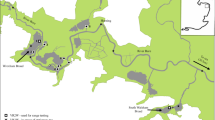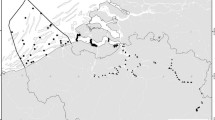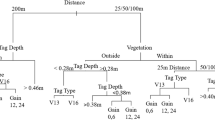Abstract
Acoustic telemetry allows collection of data on the movement and survival of fish and other aquatic organisms. The passive form of this technology uses transmitters (tags) and fixed receivers to record when an organism is present at a given location. Understanding and interpretation of these data depends on knowledge of the detection range and detection probability of the receivers. This study examines factors affecting performance of tags and receivers designed for the Juvenile Salmon Acoustic Telemetry System (JSATS) at a location in the Sacramento River in CA, USA. A group of tags (n = 13) of two power output levels, each transmitting a unique code at five second intervals, were manually moved past a set of two fixed receivers in upstream and downstream directions along transects of different distances from the receivers at two different speeds. The factors that significantly affected detection probability were tag orientation and tag movement direction. Tag orientation had the largest effect on detection probability, with higher detection rates when the tag’s piezoelectric transducer was directed towards the receiver. Detection probability (proportion of transmissions detected) was 30–50% out to 160 m. Detection efficiency (proportion of tags regarded as present) was 99–100% when tags passed within 25 m and 84–96% within 135 m of a receiver. These results have implications for the design and interpretation of acoustic tracking studies and the orientation of transmitters when implanted into fish.




Similar content being viewed by others
Data availability
Raw data available upon request to primary author. Or will be provided to journal to enable direct link to files. Custom scripts to process and analyze data were made in Matlab. Code is available upon request to primary author. Or will be provided to journal to enable direct link to files.
References
Beeman JW, Perry RW (2012) Bias from false-positive detections and strategies for their removal in studies using telemetry: Chapter 9.5. In: Adams NS, Beeman JW, Eiler JH (eds) Telemetry techniques: a user guide for fisheries research. American Fisheries Society, Bethesda
Cooke SJ, Midwood JD, Thiem JD, Klimley P, Lucas MC, Thorstad EB, Eiler J, Holbrook C, Ebner BC (2013) Tracking animals in freshwater with electronic tags: past, present and future. Anim Biotelemetry 1:5. https://doi.org/10.1186/2050-3385-1-5
Deng ZD, Carlson TJ, Li H, Xiao J, Myjak MJ, Lu J, Martinez JJ, Woodley CM, Weiland MA, Eppard MB (2015) An injectable acoustic transmitter for juvenile salmon. Sci Rep 5:8111. https://doi.org/10.1038/srep08111
Deng ZD, Martinez JJ, Li H, Harnish RA, Woodley CM, Hughes JA, Li X, Fu T, Lu J, McMichael GA, Weiland MA, Eppard MB, Skalski JR, Townsend RL (2017) Comparing the survival rate of juvenile Chinook salmon migrating through hydropower systems using injectable and surgical acoustic transmitters. Sci Rep 7:42999. https://doi.org/10.1038/srep42999
Ehrenberg JE, Steig TW (2003) Improved techniques for studying the temporal and spatial behavior of fish in a fixed location. ICES J Mar Sci 60:700–706. https://doi.org/10.1016/S1054-3139(03)00087-0
Hussey NE, Kessel ST, Aarestrup K, Cooke SJ, Cowley PD, Fisk AT, Harcourt RG, Holland KN, Iverson SJ, Kocik JF, Mills Flemming JE, Whoriskey FG (2015) Aquatic animal telemetry: a panoramic window into the underwater world. Science 348:1255642. https://doi.org/10.1126/science.1255642
Kessel ST, Cooke SJ, Heupel MR, Hussey NE, Simpfendorfer CA, Vagle S, Fisk AT (2014) A review of detection range testing in aquatic passive acoustic telemetry studies. Rev Fish Biol Fish 24:199–218. https://doi.org/10.1007/s11160-013-9328-4
Klimley AP, Voegeli F, Beavers SC, Le Boeuf BJ (1998) Automated listening stations for tagged marine fishes. Mar Technol Soc J 32(1):94–101
Klimley AP, MacFarlane RB, Sandstrom PT, Lindley ST (2013) A summary of the use of electronic tagging to provide insights into salmon migration and survival. Environ Biol Fish 96:419–428. https://doi.org/10.1007/s10641-012-0098-y
Klinard NV, Fisk AT, Kessel ST, Halfyard EA, Colborne SF (2018) Habitat use and small-scale residence patterns of sympatric sunfish species in a large temperate river. Can J Fish Aquat Sci 75(7):1059–1069. https://doi.org/10.1139/cjfas-2017-0125
Kraus RT, Holbrook CM, Vandergoot CS, Stewart TR, Faust MD, Watkinson DA, Charles C, Pegg M, Enders EC, Krueger CC (2018) Evaluation of acoustic telemetry grids for determining aquatic animal movement and survival. Methods Ecol Evol 9:1489–1502. https://doi.org/10.1111/2041-210X.12996
Lu J, Deng ZD, Li H, Myjak MJ, Martinez JJ, Xiao J, Brown RS, Cartmell SS (2016) A small long-life acoustic transmitter for studying the behavior of aquatic animals. Rev Sci Instrum 87:114902. https://doi.org/10.1063/1.4967941
McMichael GA, Eppard MB, Carlson TJ, Carter JA, Ebberts BD, Brown RS, Weiland M, Ploskey GR, Harnish RA, Deng ZD (2010) The juvenile salmon acoustic telemetry system: a new tool. Fisheries 35(1):9–22. https://doi.org/10.1577/1548-8446-35.1.9
Melnychuk MC (2012) Detection efficiency in telemetry studies: definitions and evaluation methods. In: Adams NS, Beeman JW, Eiler JH (eds) Telemetry techniques: a user guide for fisheries research. American Fisheries Society, Bethesda, pp 339–357
Simpfendorfer CA, Heupel MR, Collins AB (2008) Variation in the performance of acoustic receivers and its implication for positioning algorithms in a riverine setting. Can J Fish Aquat Sci 65:482–492. https://doi.org/10.1139/f07-180
Simpfendorfer CA, Huveneers C, Steckenreuter A, Tattersall K, Hoenner X, Harcourt R, Heupel MR (2015) Ghosts in the data: false detections in VEMCO pulse position modulation acoustic telemetry monitoring equipment. Anim Biotelemetry 3:55. https://doi.org/10.1186/s40317-015-0094-z
Steckenreuter A, Hoenner X, Huveneers C, Simpfendorfer C, Buscot MJ, Tattersall K, Babcock R, Heupel M, Meekan M, van den Broek J, McDowall P, Peddemors V, Harcourt R (2017) Optimising the design of large-scale acoustic telemetry curtains. Mar Freshw Res 68:1403–1413. https://doi.org/10.1071/MF16126
Voegeli FA, Lacroix GL, Anderson JM (1998) Development of miniature pingers for tracking Atlantic salmon smolts at sea. Hydrobiologia 371:35–46. https://doi.org/10.1023/A:1017014903313
Weiland MA, Deng ZD, Seim TA, LaMarche BL, Choi EY, Fu T, Carlson TJ, Thronas AI, Eppard MB (2011) A cabled acoustic telemetry system for detecting and tracking juvenile Salmon: Part 1. Engineering Design and Instrumentation. Sensors 11:5645–5660. https://doi.org/10.3390/s110605645
Zang X, Jung KW, Walker RW, Deng ZD (2019) The effect of fish bodies on the source level and beam pattern of acoustic transmitters in juvenile Chinook salmon. J Acoust Soc Am 145:EL554–EL559. https://doi.org/10.1121/1.5112836
Acknowledgements
This work was funded in part by an interagency agreement between National Marine Fisheries Service and the United States Bureau of Reclamation (R18PG00009). Heidi Fish and Matt Knoff provided logistical and field support. Thanks to Edward J. Dick and Eric Danner for reviewing this manuscript. This manuscript was improved by comments of two anynomous reviews. Any use of trade, firm, or product names is for descriptive purposes only and does not imply endorsement by the U.S. Government.
Funding
Provided by DOC NOAA NMFS SWFSC Santa Cruz and through an interagency agreement between National Marine Fisheries Service and the United States Bureau of Reclamation (R18PG00009).
Author information
Authors and Affiliations
Contributions
The sole author, Arnold J. Ammann, collected data in the field, processed data, analyzed data and wrote the manuscript.
Corresponding author
Ethics declarations
Conflicts of interest/Competing interests
No conflicts of interest.
Ethics approval
No live animals used in this study. Not applicable.
Consent to participate
No live animals used in this study. Not applicable.
Consent for publication
No live animals used in this study. Not applicable.
Additional information
Publisher’s note
Springer Nature remains neutral with regard to jurisdictional claims in published maps and institutional affiliations.
Rights and permissions
About this article
Cite this article
Ammann, A.J. Factors affecting detection probability and range of transmitters and receivers designed for the Juvenile Salmon Acoustic Telemetry System. Environ Biol Fish 103, 625–634 (2020). https://doi.org/10.1007/s10641-020-00987-4
Received:
Accepted:
Published:
Issue Date:
DOI: https://doi.org/10.1007/s10641-020-00987-4




